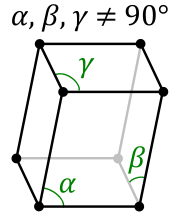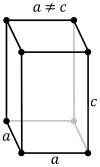Primitive cell


A primitive cell is a unit cell constructed so that it contains only one lattice point (each vertex of the cell sits on a lattice point which is shared with the surrounding cells, each lattice point is said to contribute 1/n to the total number of lattice points in the cell where n is the number of cells sharing the lattice point).[1] A primitive cell is built on the primitive basis of the direct lattice, namely a crystallographic basis of the vector lattice L such that every lattice vector t of L may be obtained as an integral linear combination of the basis vectors, a, b, c.
Used predominantly in geometry, solid state physics, and mineralogy, particularly in describing crystal structure, a primitive cell is a minimum volume cell corresponding to a single lattice point of a structure with translational symmetry in 2 dimensions, 3 dimensions, or other dimensions. A lattice can be characterized by the geometry of its primitive cell.
2-dimensional primitive cell
A 2-dimensional primitive cell is a parallelogram, which in special cases may have orthogonal angles, or equal lengths, or both.
 Parallelogram |
 Rectangle |
 Rhombus |
 Square |
The primitive cell is a primitive unit. A primitive unit is a section of the tiling (usually a parallelogram or a set of neighboring tiles) that generates the whole tiling using only translations, and is as small as possible.
The primitive cell is a fundamental domain with respect to translational symmetry only. In the case of additional symmetries a fundamental domain is smaller.
3-dimensional primitive cell
A crystal can be categorized by its lattice and the atoms that lie in a primitive cell (the basis). A cell will fill all the lattice space without leaving gaps by repetition of crystal translation operations.
A 3-dimensional primitive cell is a parallelepiped, which in special cases may have orthogonal angles, or equal lengths, or both.
 Triclinic |
 Monoclinic |
 Rhombohedral |
 Orthorhombic |
 Tetragonal |
 Cubic |
Primitive translation vectors are used to define a crystal translation vector,  , and also gives a lattice cell of smallest volume for a particular lattice. The lattice and translation vectors
, and also gives a lattice cell of smallest volume for a particular lattice. The lattice and translation vectors  ,
,  , and
, and  are primitive if the atoms look the same from any lattice points using integers
are primitive if the atoms look the same from any lattice points using integers  ,
,  , and
, and  .
.
The primitive cell is defined by the primitive axes (vectors)  ,
,  , and
, and  . The volume,
. The volume,  , of the primitive cell is given by the parallelepiped from the above axes as
, of the primitive cell is given by the parallelepiped from the above axes as
See also
References
- ↑ "DoITPoMS - TLP Library Crystallography - Unit Cell". Online Materials Science Learning Resources: DoITPoMS. University of Cambridge. Retrieved 21 February 2015.

